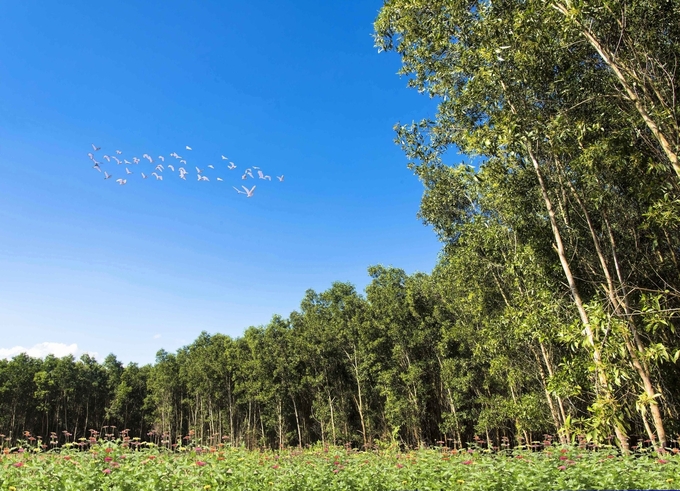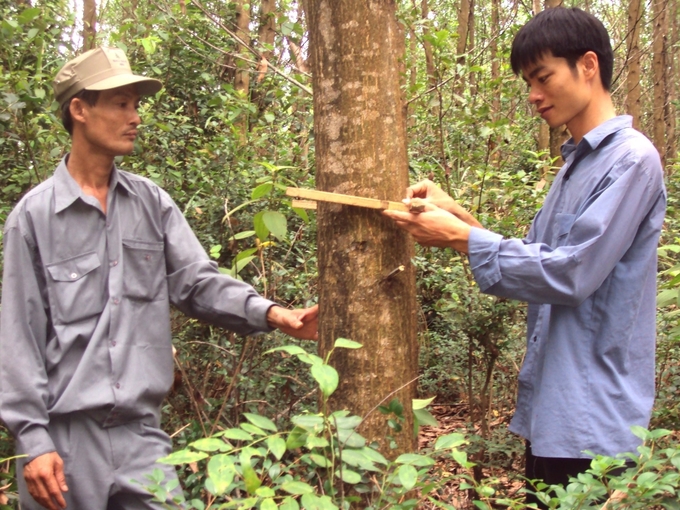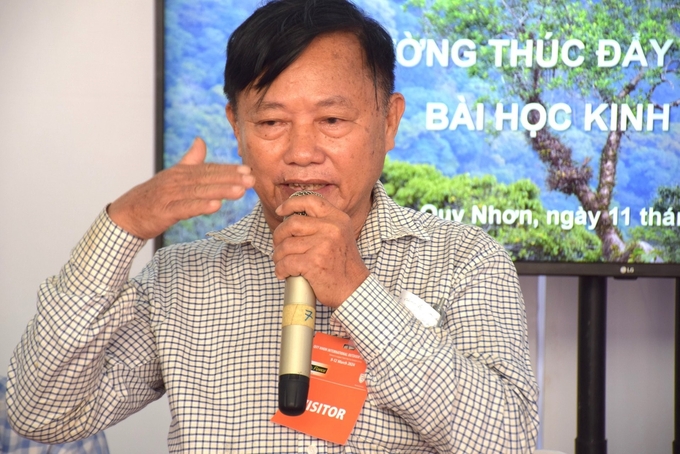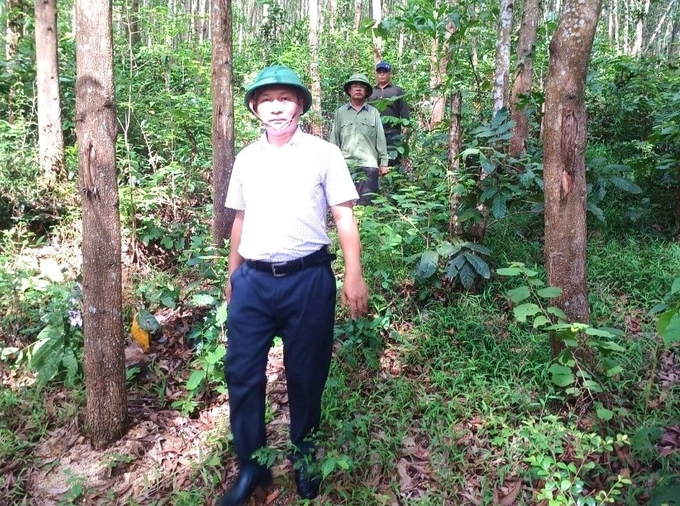November 24, 2025 | 12:49 GMT +7
November 24, 2025 | 12:49 GMT +7
Hotline: 0913.378.918
November 24, 2025 | 12:49 GMT +7
Hotline: 0913.378.918
With more than 20 years of experience in afforestation, Mr. Pham Quoc Noi, owner of approximately 30 hectares of planted forest in Tan Binh commune (Hiep Duc district, Quang Nam), has clearly seen the benefits of converting from "short-termist" afforestation to planting large timber forests. Previously, Mr. Noi sold planted forests that were only 4-5 years old, but now he raises forests until they are 8–10 years old before exploiting them.
According to Mr. Noi's analysis, planting large timber forests only costs one time for the stages of buying seeds, clearing vegetation, fertilizing, etc. In addition, in the first 5 years, the forest's growth rate is very slow, but from the 5th year onwards, the forest does not need much care but still grows very strongly; the biomass grows rapidly; and forest growers earn many times more profit.

The biggest obstacle to developing large timber forests is the worry of forests being destroyed by natural disasters. Photo: V.D.T.
"The exploitation yield of 4-5-year-old forests only reaches 65–70 tons/ha. Calculating the selling round price of raw wood from planted forests at VND 1 million/ton, the forest owner earns VND 65–70 million/ha. But if the forest is raised until it is 10 years old before harvesting, the yield will definitely reach 350 tons/ha, up 5 times compared to selling young forests. That is not to mention that the large timber trees are sold to export wood processing enterprises at a higher price than the raw wood sold to chip or pellet processing factories," Mr. Noi calculated.
According to Mr. Noi, forest growers may also know the story of planting large timber forests, which is many times more beneficial than selling young forests. However, not many forest owners are eager for large timber forests because they are afraid that forest trees that stand on the ground for a long time will be damaged by natural disasters.

Large timber forests bring 5 times more profit than selling young forests. Photo: V.D.T.
"In the Central Region, storms often occur. If forest trees encounter storms, they will definitely fall and be damaged. If planted forests are insured under agricultural insurance policies, forest growers will feel secure in planting large timber forests. In addition, most forest-planting households are poor, and all of their worries in life depend on the forest. Therefore, they exploited and sold the forests that were only 4-5 years old to provide for their children's education. If forest-planting households receive loans from the State after 5 years of planting forests so that they can continue to invest in raising large timber forests and take care of family matters, they will stick more with large timber forests," said Mr. Pham Quoc Noi.
According to Mr. Luu Cong Sang, UFBC Quang Nam Project, the Government's agricultural insurance policy has been in effect for several years, but the planted forest insurance model in Quang Nam is the first model implemented in Vietnam. The reason is that households' planted forest area is too fragmented, and the planted forests are too sensitive to storms, so insurance units are afraid to insure this crop, including 21,000 hectares of planted forests in Quang Nam that have been granted FSC certification but no area has been insured.
However, when Quang Nam benefits from the Sustainable Forest Management Component under the Sustainable Forest Management and Biodiversity Conservation (VFBC) project funded by the U.S. Agency for International Development (USAID), this locality has 154 hectares of planted forests from 40 forest owners insured by Bao Minh Insurance based on weather data. This model has delighted forest growers due to its superior mechanism.

Mr. Pham Quoc Noi, owner of approximately 30 hectares of planted forest in Tan Binh (Hiep Duc district, Quang Nam), shared about the benefits of planting large timber forests. Photo: V.D.T.
"Usually, after a natural disaster occurs to the insured object, the insurance unit will come to the field to appraise the extent of damage to the insured forest and assess the percentage of fallen trees and the percentage of trees that can be recovered to calculate the level of damage. However, for the insured forest area in Quang Nam, Bao Minh Insurance streamlines the above steps by having the forest's assets assessed by the forest owner and the compensation level based on weather data," Mr. Sang said.
Mr. Sang further explained: For example, a 4-5-year-old forest will be valued by the forest owner at VND 60 million/ha. After a natural disaster occurs, the insurance unit will collect information from weather satellites to know whether or not the storm has swept through at the coordinates of that forest based on satellite data. If that coordinate is swept by a level 9 storm with a certain radius, the insurance company does not need to know whether the forest at that coordinate is collapsed or not but will still compensate 5% of the insured property. If a level 10 storm sweeps through, the forest owner will receive 10% compensation.

If the forest is raised until it is 10 years old before harvesting, the yield will definitely reach 350 tons/ha. Photo: V.D.T.
"There are three insurance packages for planted forests, including gold insurance, silver insurance, and copper insurance. The higher the insurance package the forest owner buys, the higher the compensation level. The superiority of the planted forest insurance package is that when a storm passes through his forest, the forest owner is compensated by the insurance, regardless of whether the forest is damaged or not. If this pilot model proves its effectiveness, forest growers will certainly participate," shared Mr. Au Quoc Hieu, Manager of the UFBC Quang Nam Project.
Translated by Thu Huyen
/2025/11/21/4309-2-153400_128.jpg)
(VAN) Green and low-emission rice is paving the way for Vietnamese rice to enter high-end markets, marking the beginning of a transformation journey toward greening and elevating the national rice brand.

(VAN) ‘Right to Win’ outlines a national action plan that shapes a new vision for Viet Nam’s agriculture in an era of renewal and global integration.

(VAN) Lam Dong’s farmed sturgeon output this year is expected to reach 2,300 tons, worth VND 450 billion, affirming the brand’s position on the market.

(VAN) A surge in Ukrainian egg exports, largely driven by soaring sales to the UK over the last few years, has notably pushed up egg prices on the domestic market.

(VAN) The price of Arabica Catimor coffee in Quang Tri is currently at VND 25,000–27,000/kg (fresh cherries), the highest level ever recorded

(VAN) 'From the coffee story, we can think deeper and further about the crop production sector - from development orientations and value-chain organization to international integration,' assessed Dr Le Quoc Doanh.
/2025/11/18/2431-0-161627_248.jpg)
(VAN) Viet Nam accounts for 43% of the world's export volume of Robusta coffee. However, the Vietnamese Robusta coffee brand has yet to gain broad recognition on the global market.